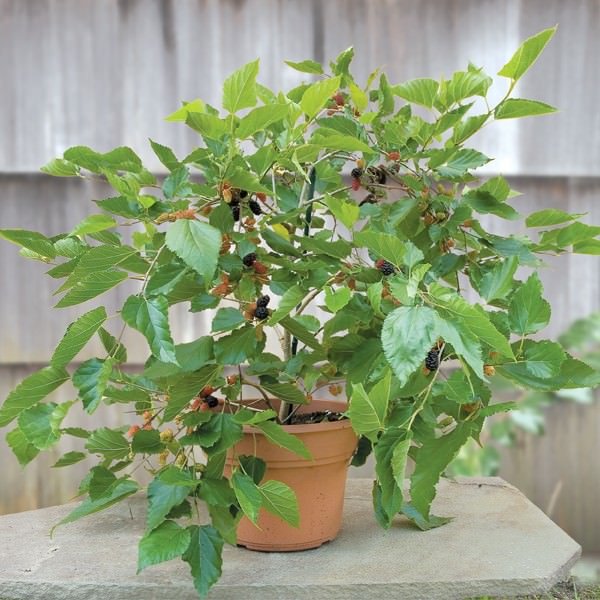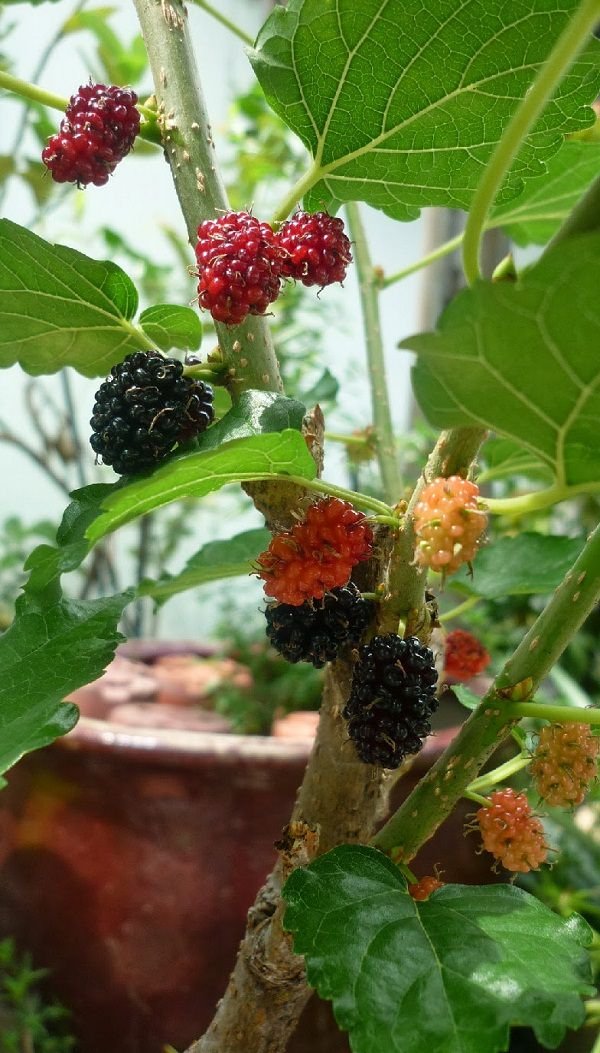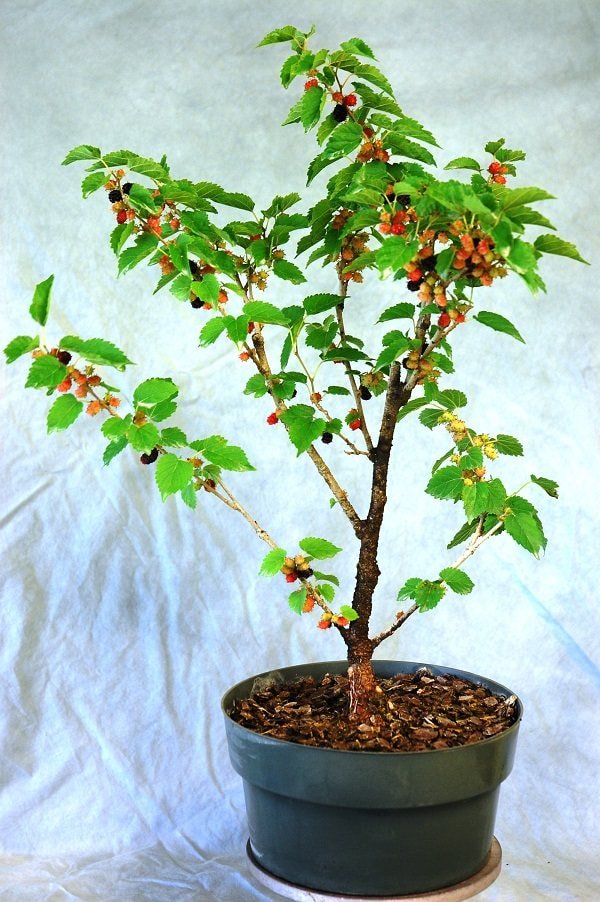Mulberry fruits are rarely available in the market due to their short shelf life but growing them in containers can allow you to taste them FRESH. Check out!
The sweet and tart, mulberry fruits are rarely available in the market due to their short shelf life and also the leaf harvest to feed silkworms don’t allow the fruit business to thrive. So, it’s a good idea to grow them in your garden or yard. But what if you don’t have enough space or you live in a freezing cold climate? In that case, growing mulberry in containers is the one option you can try. And here’s all you need to learn to do this!
How to Grow Mulberry Tree
Information about Mulberry Tree
The mulberry tree is a small to medium sized deciduous tree or large shrub. Some cultivars exceed the height of 30 feet easily but the tree can be trimmed, and height can be managed.
The cultivars vary according to the climates– Temperates, subtropical or tropical; and it is usually grown in Mediterranean part, South-East Asia, North America, Australia, Northern Africa and the Middle East.
The size of the tree and the flavor of the fruit varies according to the cultivar too. Usually, mulberry trees grow best in subtropical and light temperate regions. All the fruiting mulberry species are divided into three types, according to the color of their fruits– Red, white, and black. Note that the darker mulberries are sweetest and flavorful than the brighter ones. The mulberry tree also attracts the wildlife profusely– critters, birds, and many other wild species.
Varieties
There are many mulberry tree varieties available but the two container friendly varieties you can look for are ‘Dwarf Everbearing’ Mulberry and Mulberry ‘Issai.’ These two don’t exceed the height of 2 m. Other popular varieties are Morus alba ‘Pendula’ and Pakistan Mulberry. However, you can try any cultivar and keep the height under control by pruning.
Getting a Tree
Don’t start to propagate a mulberry tree from seeds. It is difficult, the germination rate is low, and the tree will take years to fruit if grown from seedlings. You’ll have to wait for 5-9 years for fruits, and it is also possible that seedlings you’ll grow may remain fruitless (male mulberry trees). So the best idea is to buy a grafted tree from a reputed nursery, NEARBY. This way you’ll get a self-fertile mulberry plant, and it’ll start to fruit in a year or two after planting.
Growing Mulberry Tree from Cuttings
You can also propagate mulberry trees from cuttings. Some varieties root easily; some take time. Here’s an informative article on growing a mulberry tree from cuttings, check out!
Choosing a Pot
Often people directly plant the fruit trees or shrubs in large pots, which is not right; this way the plant start to grow its roots rather than focusing on the growth above. START with small containers. For example, choose a standard 5-gallon pot (12 inches wide and deep in size) or a little bigger 7-gallon pot (14 inches deep and wide) and upgrade to one size bigger pot each time when you see the plant is getting root bound. Later increase the pot size to 15-20-25 gallons, depending on the space you have and the cultivar you’re growing.
Requirements for Growing a Mulberry Tree in a pot
Climate
The mulberry tree is found across all the continents. It can be grown in temperate regions and as well as in subtropical and arid tropical areas. It’s possible to grow it in USDA 5-10, and also in Zone 11 with slight difficulty, you can also try growing a mulberry tree in USDA zones 3 and 4 with care in winter. *When grown in cold climate expect your mulberry tree to shed its leaves in winter, the new growth begins with the slight warmth after winter.
Position
A mulberry tree, like all other fruit trees, requires plenty of sunlight to grow and fruit. Therefore, find a position that receives full day sun and has a good air flow. If you live in a warm tropical or subtropical climate, place the mulberry tree growing in the pot in a spot that receives shade in the afternoon in SUMMER.
Soil
Use rich, loamy and well-drained potting soil that is slightly acidic or neutral in pH. The mulberry tree prefers soil that is fertile and rich in compost or manure. So make sure to add this, too. For a successful container grown mulberry tree, proper drainage is necessary. Soil that blocks drainage of water must not be used. Therefore, it’s a good idea to use a SOILLESS potting mix.
Watering
Deep regular watering is essential for a few months when your plant is establishing. Ensure the soil is not remain wet. Once the mulberry tree growing in container establishes, water moderately when it is needed, you can observe it by poking the finger in top 1 inch surface of the soil. Reduce watering in winter if growing in cooler zones.
*In USDA zones 10 and 11 or in any tropical region, keep the soil slightly moist and water regularly, especially in summer.
Mulberry Tree Care
Fertilizer
Apply fertilizer moderately! During the start of growing season, you can spread the granular balanced fertilizer over the soil or feed the plant with balanced liquid fertilizer in a regular interval of 7-10 days. You can also spread a layer of well-rotted manure or compost over the top surface of the pot. Regular feeding of compost tea is also a good way to ensure optimum growth.
Pruning
Basically, in containers, you don’t need to care much about pruning than the mulberry tree growing in grounds. The best time for scheduled pruning is when the tree is dormant and not growing (in winter). You can also prune after the fruiting season ends. Slight pruning and trimming of the dead, damaged, diseased, and crossing branches can occasionally be done or at the time of requirement anytime. In tropical areas, the pruning is done after the end of summer, right before the rainy season begins.
Mulching and Covering
As you’re growing a mulberry tree in a pot, you don’t need to worry much about the freezing temperatures in winter. Below USDA Zone 7, mulching over the top surface of the soil is important to insulate the roots. If you’re keeping your pots in an exposed spot, cover them with bubble wrap.
Mulching also resists heat in summer, so a top layer of mulch is a good idea for a mulberry tree growing in a warm climate.
Pests and Diseases
In diseases, mildew, leaf spot, and root rot can be a problem. By ensuring proper drainage and avoiding over watering, you can prevent root rot. In pests, thrips, white flies, mealy bugs, spider mites, and scales may affect the growth. However, these pests can easily be outnumbered and eliminated as you’re growing mulberry in a pot.
Fruit Covering
Birds love to nibble the mulberry fruits; it’s their preferred most favorite fruit. If you’re growing more than one plant in an open area like a patio or rooftop and if the birds visit there often, you may need to cover the fruits.
Harvesting
Contrary to the name of the type of color of their fruits, some mulberry varieties bear fruits in purple to dark red or black colors, when fully mature. So, for the best flavor wait until the fruits ripen on trees completely before picking them.
Depending on the cultivar you’re growing, the mulberry fruits ripen from late spring to late summer.








Thank you for all the information about planting mulberry tree in a pot.
hope you can answer for me – I was advised to bring my morus migra pots in for the winter (Buffalo, NY). They had already lost their leaves to an early frost. Now they are shooting up so fast I’m worried I should be pruning the top? Well over 3 feet of green growth off the main stem on one of them and it’s getting very leggy. Any help for me?
Hi Cathy,
I don’t see that anyone is answering you, so I wanted to offer what I have in the way of ideas. First, I would point out that you are doing a good job if your plant is that vigorous wherever you are wintering it. I personally am in WI and the plants I winter go into an attached garage where they get limited light, cold temps, and only the water I bring them…so they’re pretty dormant. Anyway…yours is happy. I would maybe suggest backing off on plant food/ fertilizer if you are using any, as that would cause growth when you don’t want it.
Depending on how you would like the plant to end up, I don’t see much harm in taking off some of the errant growth. I figure the plant is going to lose any energy it has put into branches I don’t intend to leave…so the longer I put off the pruning, the more energy is wasted. You don’t want to take more than say, more than one fourth of the plant…and I’d be even more conservative than that if it’s small/ not well established.
Here is a link to a video where the guy is working with your same cultivar. He knows what he’s talking about:
https://www.youtube.com/watch?v=KNTbTgEJzys
Best of luck.